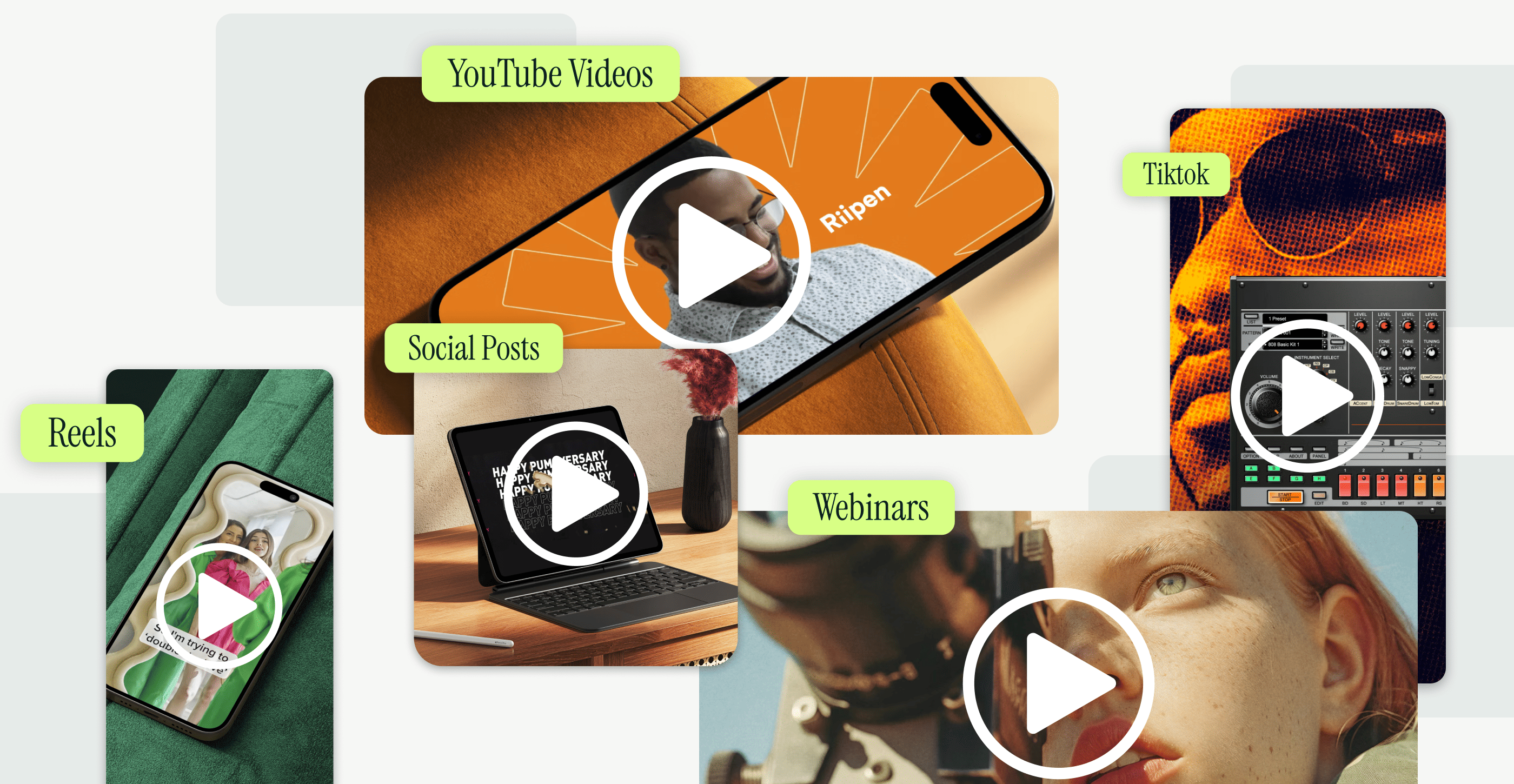
Storytelling is one of the most powerful tools in any marketer’s toolkit.
Storytelling can help you create meaningful connections with your audience and focus your message on their needs. It can help you define and hone your company’s personality and build a stronger brand image. It can also help you develop a more powerful brand message. Sharing a similar story across multiple touchpoints can help build trust with your audience and guide potential customers through your customer journey.
But what does good storytelling marketing look like? And where do you start? We recently held a great webinar on this topic as a part of our Gather & Grow series and it inspired us to bring it to life on the blog.
In this post, we’ll break down what storytelling is, give you some tips on telling better stories with your marketing and share a brand storytelling case study to inspire your marketing efforts.
Quick video summary:
5:45 - Intro to the session topic and why storytelling matters
7:10 - Know your customer
15:15 - Know your brand and your market/competition
22:25 - Data is important, but don't let it paralyze you
28:40 - Build integrated and purposeful copy and creative for your customer
33:50 - Brüush case study
What is Storytelling Marketing?
Storytelling in advertising or marketing is essentially the combination of two key elements: purposeful copy and creative. Your brand’s written and visual language should work together to create a consistent narrative that engages your customers and highlights your offer’s value – all in a way that feels authentic and natural.
We’ve all seen those brands that feel a little cringy, either because their marketing doesn’t fit their brand’s personality or speak to their target audience. Good storytelling marketing is the antithesis of that – crafting a narrative that’s so compelling that purchasing the brand’s product or service feels like a ‘no-brainer.’
So how do you produce that kind of marketing? Before you even decide what your copy and creative will look like or sound like, you need to follow a few fundamental steps.
1. Know your customer
An effective brand persona is a mix of data, insights and intuition. While demographic data points like age, gender and geography are helpful, your brand persona should also give you a lot of insight into your customer’s lifestyle.
- What are their values?
- Where do they go to find information?
- What kind of podcasts do they listen to?
Try to add as much color to your customer description as possible.
From there, you can start developing integrated storytelling that addresses your customers’ needs, gaps and barriers and illustrates how your brand fits into their lives. Also, remember that this is an iterative process. You should constantly revisit your customer personas, vet them against your customer data and evolve and update them as needed.
2. Know your brand, market and competition
You need to clearly understand your brand and what role you play in your consumer’s life. You also need to be realistic about your target market’s engagement with your product or service and the impact it will have on them. Lastly, be diligent and rigorous about understanding your competitors, market and culture. Watch out for crucial shifts, differentiators and table stakes claims and offers.
3. Data is important, but don’t let it paralyze you
Data is wonderful, but it is not the be-all, end-all in modern marketing. Establish KPIs and goals, but don’t get too obsessed with the nitty-gritty, daily metrics as they only tell a piece of the story.
Remember: you’re creating content for human beings. Likes and clicks are great, but you also need to know what your audience thinks and feels about your offer as well. Also, leave room for creativity. The best way to learn what works and what doesn’t is to try things out and see what happens.
4. Build integrated and purposeful copy and creative for your customer
Do you know where your offer fits into the market or how you solve your customers’ problems or fill a particular gap? Understanding your niche and what makes you unique is a vital part of creating purposeful copy and creative.
Once you’ve nailed down your messaging, make sure that it’s cohesive and connected across all your marketing channels to reinforce your brand messaging. And as always, you should constantly test, learn, iterate and improve your marketing approach.
Storytelling in Marketing Case Study: Brüush
Want to see what gold standard marketing storytelling looks like in action? Here’s a look at a rebrand case study by Gather & Grow speaker Kristen King, Partner and Brand Strategist at August Strategy.
Her client, Brüush, is a DTC electric toothbrush company based in Vancouver, Canada. When Brüush hired Kristen’s strategy firm, their mandate was to accelerate sales – and fast. But Kristen’s team recognized early on that they had a great opportunity to sharpen and refine their client’s strategy and visual language, which they knew would help them reach their goals even faster.
Step 1: Study the competition
Kristen’s agency started by studying the competition beyond what they offer. They analyzed how they communicate, who they’re speaking to and where they’re showing up.
“When we started to look at the reviews, what we noticed was even in the early days, when they didn't have tons of consumers, they had crazy positive reviews. And people weren't talking about the features,” said Kristen.
“They weren't saying, ‘Oh my gosh, I love that Brüush has six modes,’ they were saying, ‘When I use this toothbrush, I feel like I've gone to the dentist. I feel like I've never had teeth this clean before.’”
The feedback was all about the feeling that their customers had after using the product and nothing about the very functional benefits, which is what their competition was focusing on.
Step 2: Build robust customer personas
They then leveraged this consumer data to develop robust consumer personas that offered both demographic and lifestyle information, such as their persona’s purchasing habits, values, interests, and even the devices they used.
Step 3: Refresh the visual language
From the new personas and digging into what their customers were already saying about the product, they refreshed the visual language and overall brand strategy, honing in on the feeling you get when using Brüush.
“When we were casting for our campaign, we intentionally chose models that didn't have orthodontist-perfect teeth because that's not the reality of what our consumers are living every day,” explained Kristen. “We wanted people that had imperfections in their teeth. Two of these models aren't even models. They were friends and people in the community that we thought really express the vibrancy and the energy of the brand.”
In a market saturated by sterile claims and ‘features over benefits’ messaging, Brüush’s feelings-focused storytelling stands out.
Step 4: Tell a cohesive story
Kristen’s team weaves storytelling through the brand’s various prospecting and retargeting campaigns, delivering a synergistic message tailored to what the consumer is looking for at that moment. They even extended their storytelling through a multi-video campaign with the brand’s new spokesperson, Kevin Hart.
Even when they’re highlighting the “features” of the product, the creative still tells a story. For example, the images above outline the different cleaning modes. The toaster image represents their “Daily” mode, the butterflies are for the “Gentle” mode, the gum quite literally represents their “Gum” mode and the crocodile represents their “Max” mode.
Final Thoughts
Purposeful branding is not just about nailing your audience targeting and using data to inform your decisions. It's about infusing your brand's personality into every touchpoint, connecting with the consumer and having a clear purpose.
Proper brand storytelling is all about having a cohesive message. Not only that, but your message needs to resonate with your target audience. Often, companies fall into the trap of trying to force a brand purpose onto their business – but this can come off as inauthentic (and people will pick up on that).
Telling better stories starts with having a deeper understanding of who you’re telling those stories to. Once you know your customer, brand, market and competition, you can start crafting stand-out messaging and creative that answers your customers’ questions and positions your brand as the go-to in your space.












